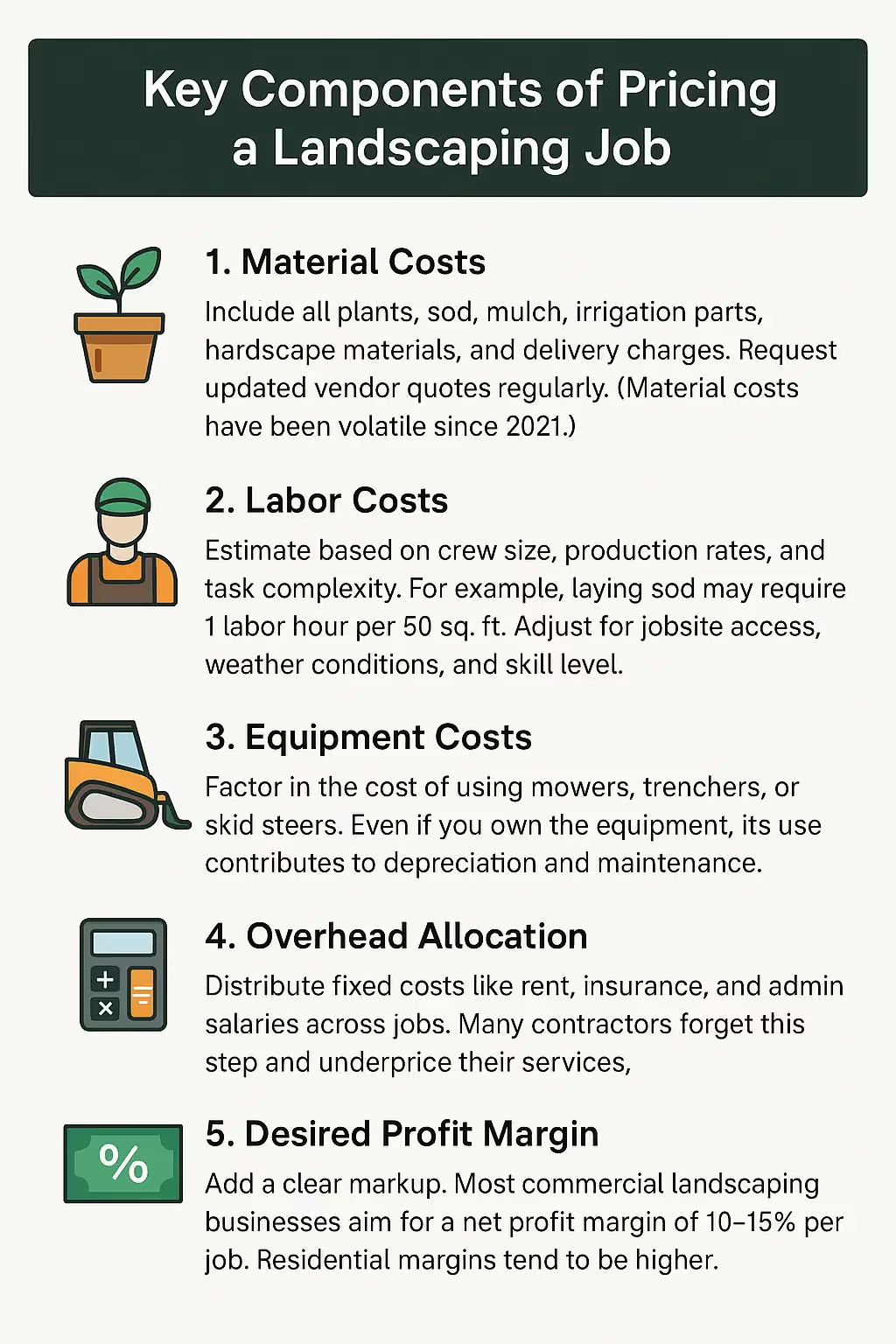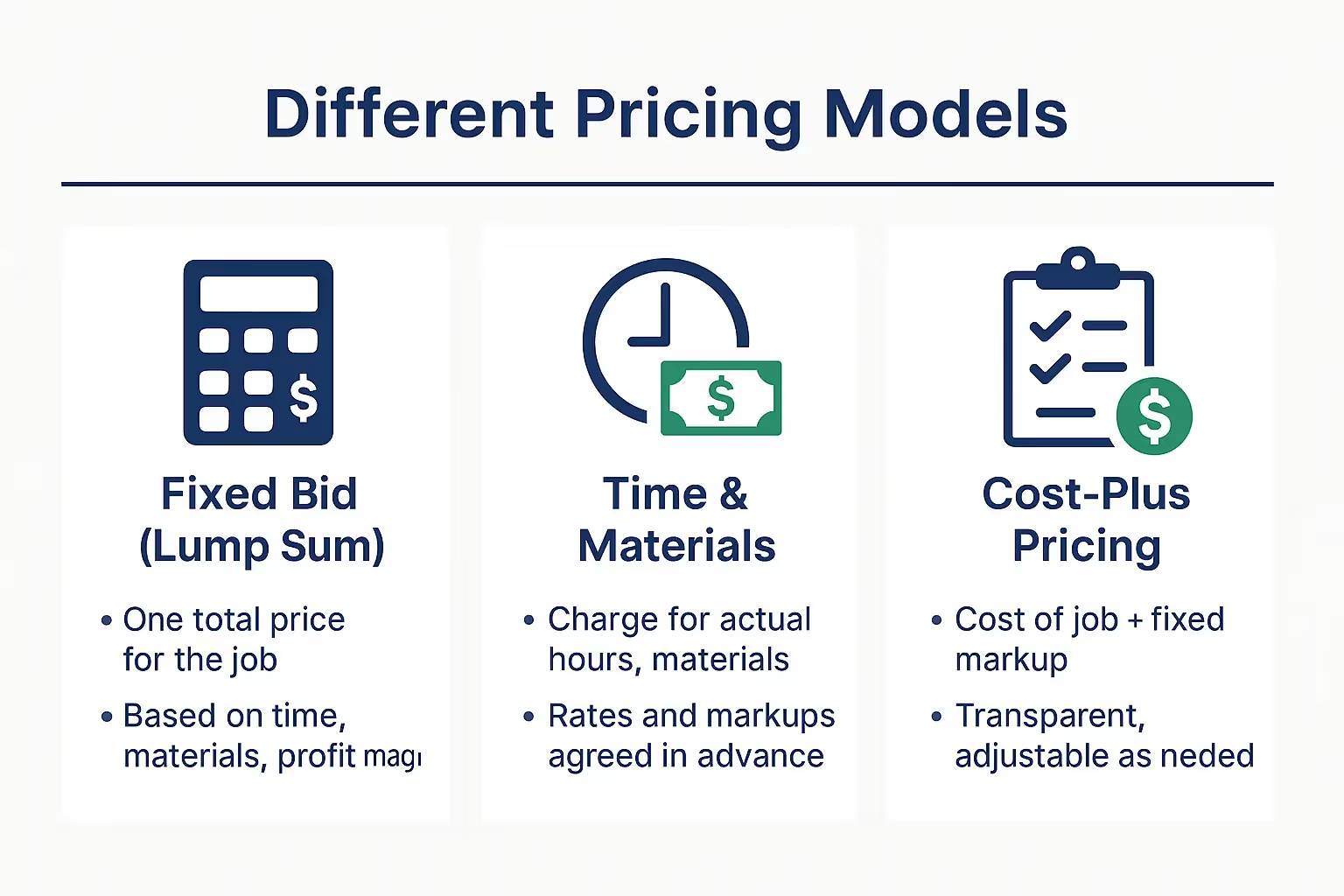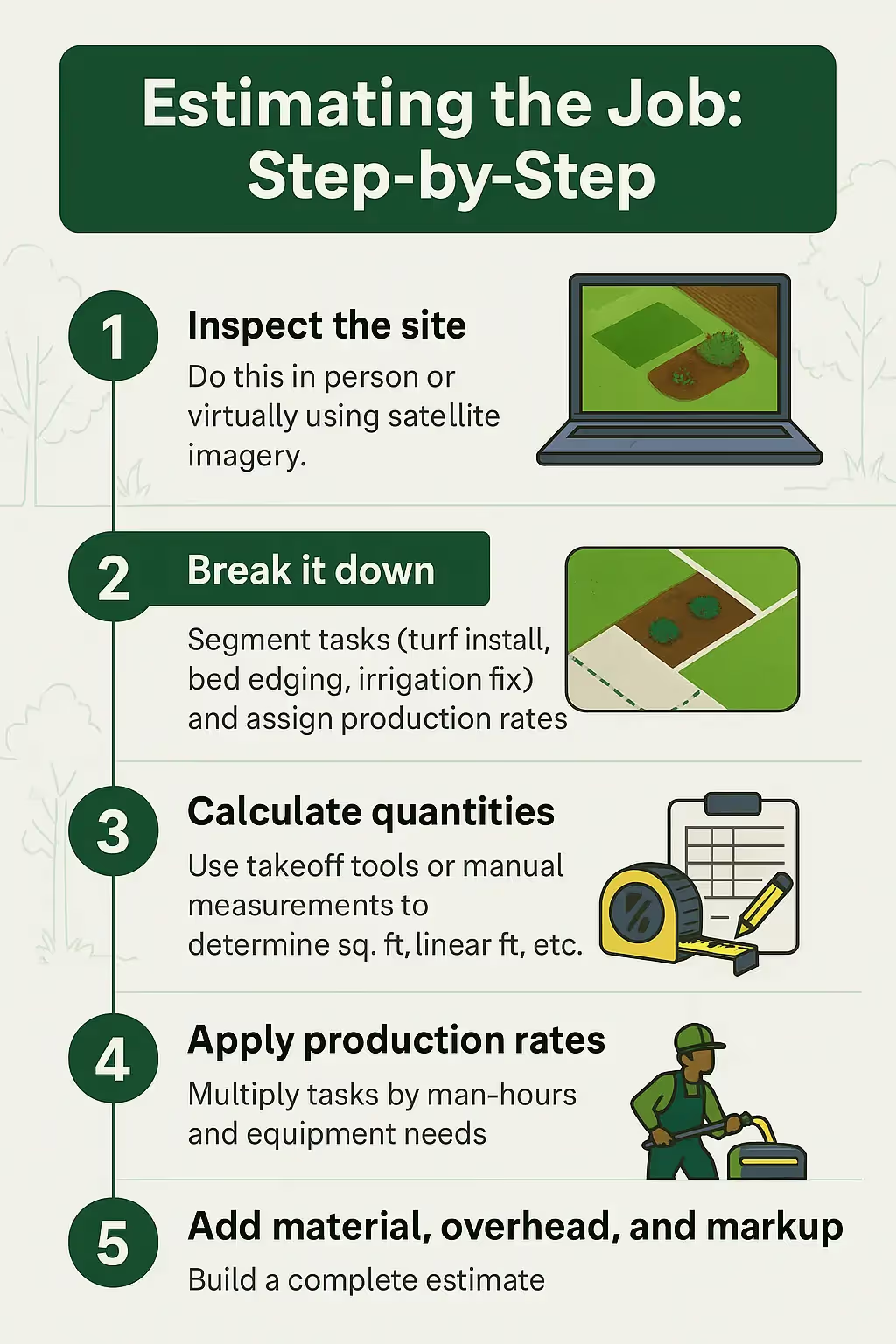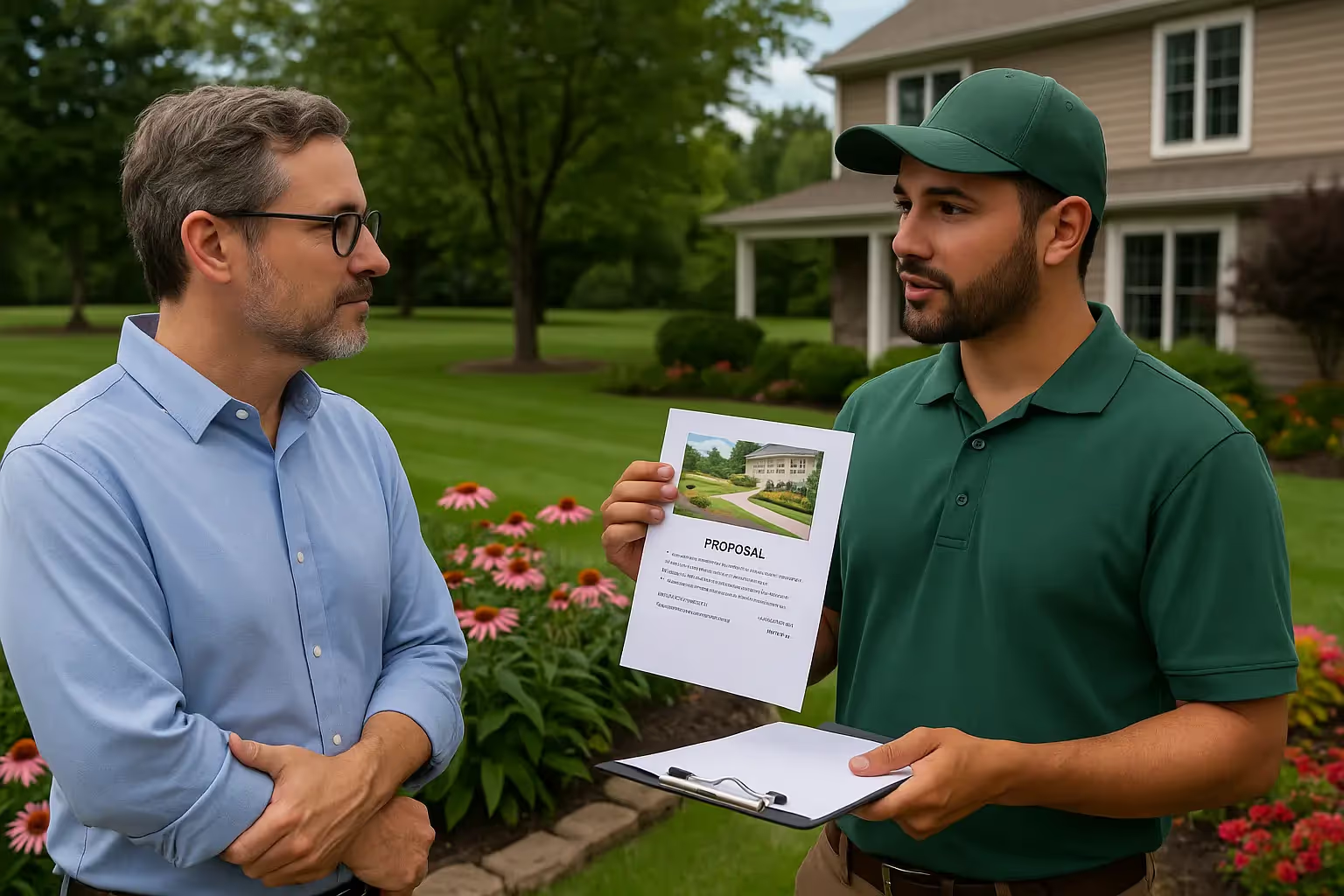How to Price Landscaping Jobs: A Comprehensive Guide
Learn how to price landscaping jobs accurately using real-world data, pricing models, & estimating strategies tailored for residential & commercial work

Key Takeaways:
Landscaping pricing involves calculating material, labor, equipment, overhead, and profit margins. Estimators choose from models like fixed bid, time & materials, or cost-plus depending on the job. Factors such as project complexity, location, client expectations, and seasonality influence pricing decisions. A five-step process- site inspection, task breakdown, quantity calculation, applying production rates, and final markup, forms the basis of accurate quotes. This guide also covers sales tactics, market adjustments, residential vs. commercial differences, common pricing mistakes, and FAQs.
How to Price Landscaping Jobs – A Comprehensive Guide
Pricing landscaping work isn’t just about counting how many square feet of sod you’ll need or how many yards of mulch it’ll take. It’s about understanding your costs, your clients, and your crew and then building a system that delivers profit consistently, not just occasionally.
In the field, we’ve all seen it- price too low, and you win the job but lose your margin. Price too high, and your bid never gets a call back. This guide breaks down what actually goes into pricing landscaping jobs the right way, combining years of industry insight, data-driven methods, and examples from companies that have moved from guesswork to growth.
Why Pricing Matters for Landscaping Businesses
A well-thought-out pricing strategy is the difference between scaling your business or getting stuck in low-margin work. Inconsistent pricing leads to:
- Missed profit opportunities
- Eroded trust with clients
- Inaccurate job costing and forecasting
On the other hand, a standardized approach to pricing gives you control. It ensures every estimate reflects the true cost of delivering high-quality work and allows you to train teams and scale operations without relying on a single estimator’s judgment.

Pro Tip: Avoid using gut feel or flat hourly rates. A line-by-line breakdown rooted in production rates and actual cost data is what drives predictable profit.
Different Pricing Models
How you structure your pricing can significantly influence profitability, client relationships, and the ability to manage scope changes. There’s no one-size-fits-all approach, each model has trade-offs.

1. Fixed Bid (Lump Sum)
You quote one total price for the job based on your estimate of time, materials, equipment, and profit margin. This is the most commonly used model in landscaping.
Best for:
- Clearly defined scopes (e.g., lawn installs, bed cleanups, spring cleanups)
- Recurring maintenance contracts with predictable tasks
Pros:
- Easy for clients to understand and budget for
- Less administrative work (no need to track exact hours/materials)
- If you're efficient, you can improve your margins
Risks:
- You carry all the risk if you underestimate time, labor, or material needs
- Any changes or surprises (weather delays, access issues, scope creep) eat into your profit unless you have solid change order processes in place
When to use:
When the scope is detailed, job conditions are predictable, and you have good production data. Always build in a contingency buffer for unknowns.
2. Time & Materials (T&M)
You charge based on actual time spent (labor hours) and materials used, typically with hourly rates and material markups agreed in advance.
Best for:
- Open-ended or unpredictable projects
- Repair work, service calls, or enhancement jobs where the full scope can’t be determined upfront
Pros:
- Lower risk for you, you’re paid for what the job actually takes
- Easy to adjust pricing if scope expands
- Can build trust if you provide detailed, transparent billing
Risks:
- Clients may perceive it as open-ended or hard to budget
- Requires accurate time tracking and strong documentation to avoid disputes
- If your crew isn’t efficient, you’re not incentivized to improve productivity
When to use:
For unknown conditions, mid-season upgrades, or ongoing service work where it’s difficult to scope everything at once. T&M is also useful for change orders added to fixed-bid contracts.
3. Cost-Plus Pricing
You charge the client the actual cost of completing the job (labor, materials, equipment, etc.) plus a fixed fee or percentage markup to cover profit and overhead.
Best for:
- Large or complex projects with variable scopes
- Design-build work, multi-phase installations, or fast-track projects where scope evolves
- Jobs where transparency is valued over a flat number
Pros:
- Gives flexibility to adjust as the job progresses
- Encourages collaboration with the client, particularly in design-build scenarios
- Less risk of underestimating and losing money
Risks:
- Requires the client to trust your process and accept less cost certainty
- You still need to track job costs meticulously and communicate changes frequently
- Can be less competitive in bid situations where buyers are comparing lump sums
When to use:
With clients who want transparency or flexibility (e.g., builders, developers, high-trust relationships). Works best when you’ve established credibility and are seen as a strategic partner and not just a vendor.
Pro Tip: Some contractors use hybrid models: fixed pricing for base services, with T&M or cost-plus pricing for add-ons, enhancements, or unexpected changes. This balances predictability for the client with flexibility for you.
What Influences Your Pricing?
- Project complexity: Multi-phase commercial installs require more contingency than simple mow-and-blow contracts.
- Geographic location: Wages and materials cost more in metro areas.
- Client expectations: HOA board vs. real estate investor vs. homeowner, each has different quality standards and price sensitivity. (Not sure how to tailor your quote to different client types? Download the Needs Assessment Guide to ask the right questions before pricing.)
- Seasonality: Spring demand spikes. Smart contractors factor in premium pricing for urgent timelines.

P.S. - Need help with accurate man-hour benchmarks? Download the free Production Rates Guide for real-world data on how long common landscaping tasks should take.
Real-World Example: Pricing That Scales
How EnergyScapes Added $1M in 8.5 Months
Before switching to SiteRecon, EnergyScapes relied on spreadsheets and manual takeoffs. This caused slow turnaround and inconsistent pricing across sales reps. After adopting SiteRecon’s estimating tool, they:
- 10x’d their bidding capacity
- Reduced turnaround from days to hours
- Improved close rates by 30%
"The numbers speak for themselves - $1M in 8.5 months. But it’s more than that. It’s the confidence I have now knowing our estimates are rock solid and our process is scalable."—Austin Evans, EnergyScapes
This is what pricing systems do, they not just calculate cost, but build confidence across your sales team.
Sales Tactics: Presenting Your Price Confidently

Pricing isn’t just math, it’s psychology.
- Always anchor with value: Tie pricing to outcomes like safety, long-term savings, or aesthetics.
- Break down the scope: Clients appreciate clarity. Don’t just say "$12,500", explain what’s included. Once your price is ready, your proposal matters just as much. Grab the Winning Proposal Checklist to make sure your bids cover everything clients care about.
- Offer options: Provide good-better-best tiers. This turns price into a conversation, not a yes/no decision.
- Use visuals: Site maps, before/after images, and estimated completion timelines help clients see what they’re paying for.
Pro Tip: A clean proposal with line-item pricing and a map beats a one-line quote. Every time.
Adapting to Market Conditions
Inflation, labor shortages, and material delays have made landscaping pricing more volatile than ever. Adjust:
- Material markups to reflect supplier price hikes
- Labor rates based on regional shortages
- Contingency buffers for unknowns in long-duration projects
Smart contractors review pricing models quarterly and not annually.
Pricing Residential vs Commercial Jobs
P.S.-Tailor your pricing strategy to client type. One-size-fits-all rarely works.
Common Pricing Mistakes
- Ignoring overhead: This leads to invisible margin loss.
- Underestimating labor time: Production rates must reflect real-world conditions.
- Not updating prices: If material costs changed last quarter, your pricing should too. (Want to avoid overlooking key costs? Use this free Landscape Estimate Template to organize labor, material, overhead, and profit into one professional document.)
- Avoiding markup conversations: Build confidence in your pricing. If your estimate is solid, stand by it.
Close More, Lose Less: The Power of Systematic Estimating
Takeoff tools and estimating systems aren’t just for speed, they’re for profit.
- **Greenscape saved 300+ sales hours and added $100K per rep** using SiteRecon.
- **Greenery Inc. doubled proposals sent and improved close rates** by standardizing estimates and adding visuals.
These companies aren’t winning on price. They’re winning on clarity, speed, and consistency.
When your pricing system is standardized, easy to review, and trusted by your team, then you quote faster, negotiate better, and scale sustainably.
Want to take your estimating skills to the next level? Watch the free 5-part Landscape Estimating Masterclass featuring Fred Haskett and learn how top landscapers price to win.
Want to Price Landscaping Jobs with Confidence?
With SiteRecon, you don’t just get measurements. You get:
- Takeoffs tied to real-world production rates
- Done-for-you estimates for enhancements, installs, and maintenance
- Proposal-ready visuals for client trust and sales team efficiency
Book a demo and see how top landscaping companies are pricing smarter, not just faster.
Frequently Asked Questions
What is a fair profit margin for landscaping jobs?
Most commercial landscaping companies aim for a 10–15% net profit margin per job. Residential jobs may see higher margins depending on project scope and client expectations.
Should I charge for landscaping estimates?
Many landscapers offer free estimates to stay competitive. If you're doing detailed site visits, consider including the cost in your overhead or charging a refundable consultation fee.
How often should I update my pricing model?
At least quarterly. Material and labor costs can shift quickly. Regular reviews ensure your pricing remains competitive and profitable.
Is there a formula for calculating a landscaping quote?
Yes. Total price = (Materials + Labor + Equipment + Overhead) + Profit Margin. Using standardized production rates and a digital takeoff tool helps ensure accuracy.
Which pricing model is best for commercial landscaping?
Fixed bids work well for predictable maintenance contracts, while cost-plus or time & material pricing may suit custom projects or long-term installs with unknowns.
FAQs
Take your business to the next level
Find out how SiteRecon's AI remote takeoff and land measurement tools can speed up pipeline, improve bid accuracy and increase sales

.avif)


.avif)